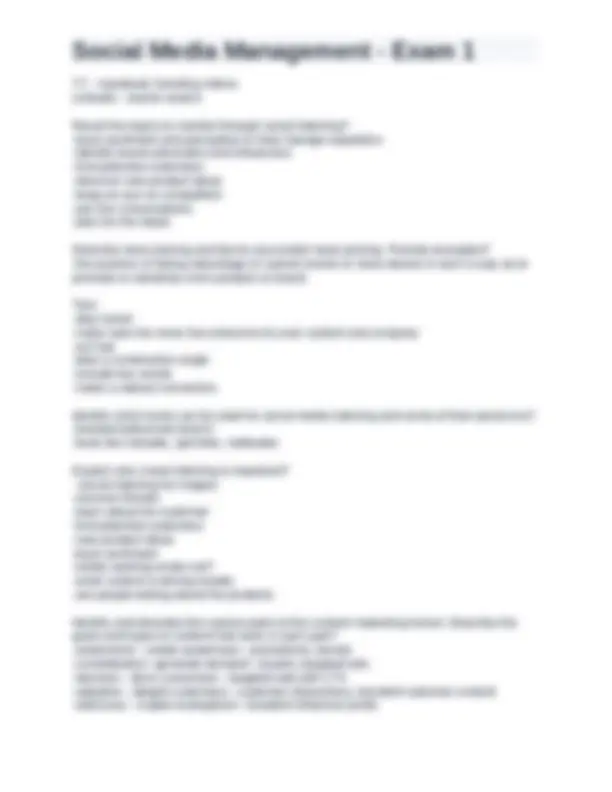





Study with the several resources on Docsity

Earn points by helping other students or get them with a premium plan


Prepare for your exams
Study with the several resources on Docsity

Earn points to download
Earn points by helping other students or get them with a premium plan
Community
Ask the community for help and clear up your study doubts
Discover the best universities in your country according to Docsity users
Free resources
Download our free guides on studying techniques, anxiety management strategies, and thesis advice from Docsity tutors
The impact of social media on public relations, the characteristics that set social media apart from other digital media, best practices for ethical use of social media, steps to build a social media strategy, outcome and output objectives, quantitative and qualitative measurement, standard social media best practices across platforms, unique features of various social media platforms, tips for writing social media copy, benefits of long-tail keywords, factors that contribute to content marketing success, and reasons why people share content.
Typology: Exams
1 / 6

This page cannot be seen from the preview
Don't miss anything!




How has social media changed public relations Before social media? -public relations relied on traditional communications channels, such as print, TV and radio -Journalists served as gatekeepers to the news 65% of PR departments are responsible of the social media presence of their company The characteristics that set social media apart from other digital media? -stories -AI powered customer service -personalization Social media makes it easier for businesses to? -Engage in two-way dialogue -Learn about their customers -Track sentiment and perception -Build online communities and turn customers into brand advocates -Target niche markets and demographics -Increase visibility and reach untapped markets Describe best practices for the ethical use of social media? -no defamation -no copyright or trademark infringement -no plagarism -ask permission before reposting others content -fair use Identify and describe the steps to build a social media strategy. Evaluate why they're important
Compare and contrast content creation and content curation? Content creation - content you create yourself Content curation - gathered and shared by users and credible sources Identify the parts of the content marketing funnel and your audience's mindset at each? unaware problem aware solution aware product aware most aware awareness - prospects evaluation - leads conversion - informed purchase decision Summarize how and why companies use editorial content calendars? -it's an easy and efficient way to keep track of your content and key dates -what to include (week, day, copy, pic, topic, platform, time/time zone, etc) -pick the platform thats best for your team 9excel, hootsuite, etc) Compare and contrast linear story arcs and non-linear story arcs in video. Know which is more effective and why? linear - present stories in a logical manner by telling what happens from one point in time to the next without using flashbacks or flash-forwards and then returning to the present. non linear - where events are portrayed, out of chronological order or in other ways where the narrative does not follow the direct causality pattern of the events featured, such as parallel distinctive plot lines, dream immersions or narrating another story inside the main plot-line Identify the various copywriting frameworks: PAS, AIDA, PAPA. PAS - Problem Agitation Solution AIDA - Attention Interest Desire Action PAPA - Problem Advantages
Proof Action Recall tips for writing social media copy? -lead with whats important -know the character limits -ask open ended questions -call to action -drive traffic to your site -triple check links -put your audience first -talk human -use relevant key words and hashtags -tag users and fans -proofread and revise -TEST Recall the benefits of long-tail keywords? -long-tail keyword phrases are longer, more specific search terms that better describe a particular thing or concept, for instance, "cheap gucci men's shoes". Benefits -less competition -substantial traffic -better targeted traffic -higher conversion rates -great for competitive niches -easier to optimize for Identify ways to strategically select keywords? -think of the customer -study the competition -understand the long tail keyword -use keyword search tools -analyze the results Defamation is a statement that injures someone's reputation. Libel is a form of defamation that refers to written or recorded communication, including social media posts and content intellectual property Any product of the human mind that is protected by law from unauthorized use by others Copyright Claim to IP rights of an original work of authorship (e.g. music, pictures, graphics, literature, etc.) trademarks